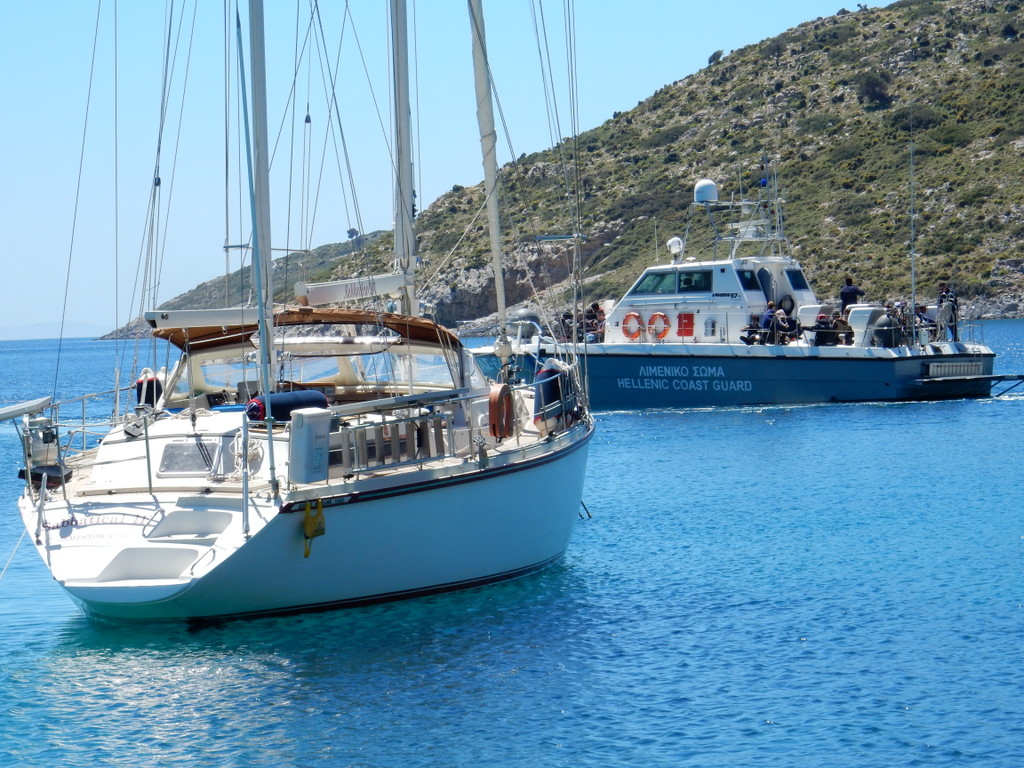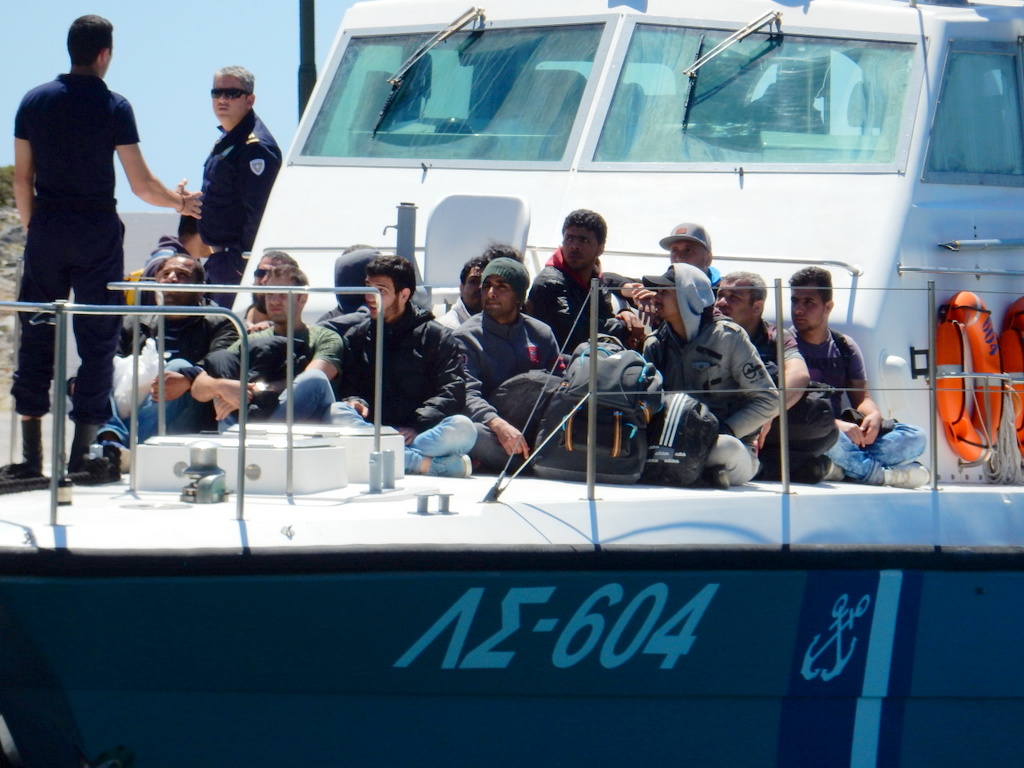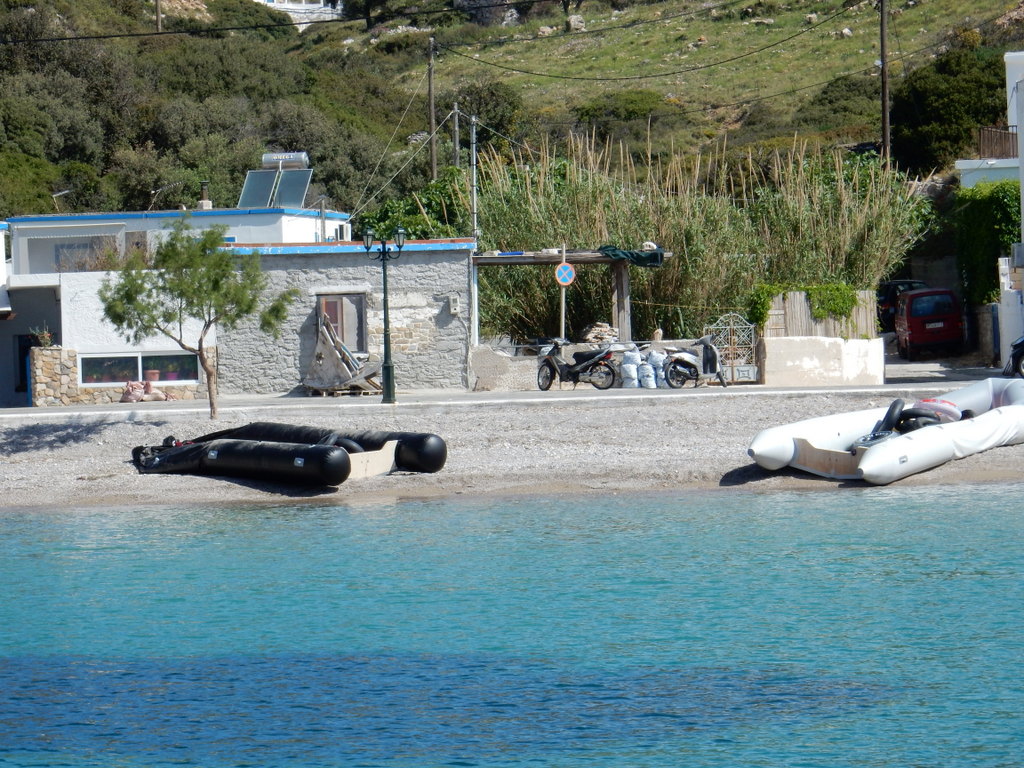

There were Syrian refugees in the tiny Greek town of St. George’s on AgathonisiIsland where we spent the last few days. They show up every night here, arriving on large inflatable rafts, from somewhere on the Turkish coast. Let me describe the town and the setting. The bay in Agathonisi is very small. There is room for 2 or maybe three boats to anchor and some additional room at the town quay for another 3 boats to Med moor to shore. There is a very large concrete dock that pretty much takes over the entire eastern side of the bay. We think it was built to accommodate the ferries that come in a few times a week to deliver goods or people to the island. Most of the time the islander’s fishing boats tie up next to it until the ferry arrives, and then they move off to accommodate the larger boat’s needs. There are only seven or eight commercial establishments in town, all facing the little bay: two tavernas, a snack/coffee shop, two tiny grocery stores and a couple of homes offering rooms to rent. There might be a couple hundred year round residents on the island. There is also a small rocky beach in the bay that the local kids and occasional tourist go for a swim.
We pulled into the bay on Wednesday, the 29th of April, at about six pm, and were pleased to find ourselves one of only two visiting boats in the anchorage. From the anchorage you are only 50 feet from the stores and tavernas and we could see the locals going about their business as usual… painting new signs for the little general store, the local policeman washing his car, a few moms with baby carriages pushing their kids down the sidewalk. We also noticed a large group of men sitting in the opening of a building that seemed to be a community center, just 50 feet up the hill from the main street. We assumed it was some type of party.
The next morning when we looked out, we saw that there were even a larger group of people gathered on the patio of the community center, and also about 30 men sleeping, or sitting in small groups, on the large concrete dock near us. Most were dressed in blue jeans, and jackets. Most had back-packs. Still totally not cognizant of what was going on, we decided they must be day-laborers brought to the island to do some work. But, it didn’t take too much longer for us to realize that they were refugees. There is a small army presence on the island and before long some official looking Greek men started organizing the men on the dock into small groups, and had them line up. A small chartered ferry soon arrived and part of the group of the men climbed on-board and were ferried away. The remaining men that were on the dock were loaded onto the deck of a Greek Coast Guard cutter An hour later we saw a larger group of people start to come down from the community center. It was mostly men, but also a few women and children. The women were dressed conservatively, with headscarves and long skirts. All of these people were lined up in groups and quietly waited for the next bigger ferry to arrive and take them away.


In the meantime, there was no sign of unease among the Greeks onshore. Kids continued to ride their bikes around, some young women were sun-bathing on the beach, and the townspeople continued their local business, most of them scooting in and out of town on motor-cycles. The small fishing boats came and went on the docks as well.
We went onshore and spoke to the woman who runs the small grocery store to ask about what was going on. She told us that the refugees arrive almost nightly. She guessed there might have been 500 or more this year. They come in large (but not large enough) inflatable boats (see photo). A Greek coast guard cutter is positioned a few miles off-shore (see photo) and she said it has become almost a daily occurrence that one or more groups of these immigrants show up in the middle of the night on Agathonisi. There they await transfer (usually within a day) to the larger island of Samos, and then on to Athens and ultimately elsewhere in Europe. This is undoubtedly happening on all of the Greek islands that are close to Turkey.
She said that these people tended to have some resources… many had cash andpurchased food in the store, and as far as she could tell us, they had paid fairly significant amounts of money to get on the boats that took them from Turkey to Greece (which meant they now would have access to other EU countries).
For the day or so that they are on Agathonisi they must stay in the little community center. There they are provided with food and drink. We walked by the center a few times and although we didn’t want to “spyâ€, we couldn’t help trying to see what was going on. The women and children looked healthy and even smiled and waved at us. The men were very quiet. Since these were the ones who have “made itâ€, I am guessing that despite their travails and uncertain future, they might have been feeling quite a bit of relief of having made it safely to the EU.


On our third night in Agathonisi we were awakened at 3:00 am by cries coming from close by. We looked out and saw a Coast Guard boat positioned near the concrete dock. Behind it was an inflatable dinghy sitting low in the water with what looked like about 20 people onboard. Another 20 people had already jumped or fallen out of the dinghy, into the very cold water, and were frantically trying to swim to the tall concrete dock while calling out loudly in Arabic. Women were screaming. It looked like the people in the water did not really know how to swim, and besides it was dark, and the water was cold, and they were trying to maintain their backpacks. It was also clear, however, that the Coast Guard was not about to let anyone die, and those in the water made it up onto the dock within a few minutes. The only words we could make out were “English?†and “baby!â€, which was pretty heart-stopping. The others, who had remained in the inflatable had an easier time as they were pulled right alongside the Coast guard boat and were helped onboard and then they were able to walk onto the dock without getting wet. All had life jackets. There was a full moon so it was quite easy to see what was happening, plus we were anchored quite close by. We still can’t understand how they get from Turkey (11 miles away) to this little island on those inflatables. We don’t think there was even an engine on them and 11 miles is a huge distance at sea in an overloaded inflatable raft. Perhaps they set out from Turkey on a larger boat and then they get dropped off once they are in sight of Greek land and/or a Coast Guard ship. It is hard to understand and extremely disturbing to witness.
The group was led off to the community center and the next morning we saw them all sitting in the warm sun, hopefully somewhat rested and rehydrated. We took a walk to the local dumpster to drop off some trash and found all of the large trash containers filled to overflowing with the discarded life-jackets of the refugees. They must be throwing out hundreds and hundreds of these. The inflatable dinghies get punctured (probably by the Coast Guard), their plywood bottoms removed, and then these also get trashed. It’s a lot for a small island to absorb.
We left Agathonisi on Sunday, and headed to the nearby island of Arki which is not getting any of the refugees. It is another 10 miles further from the Turkish coast which probably explains the difference.
All is well on board Sabbatical III. We are safe and well and have to say that we are having an interesting year.
L.


Comments are closed.